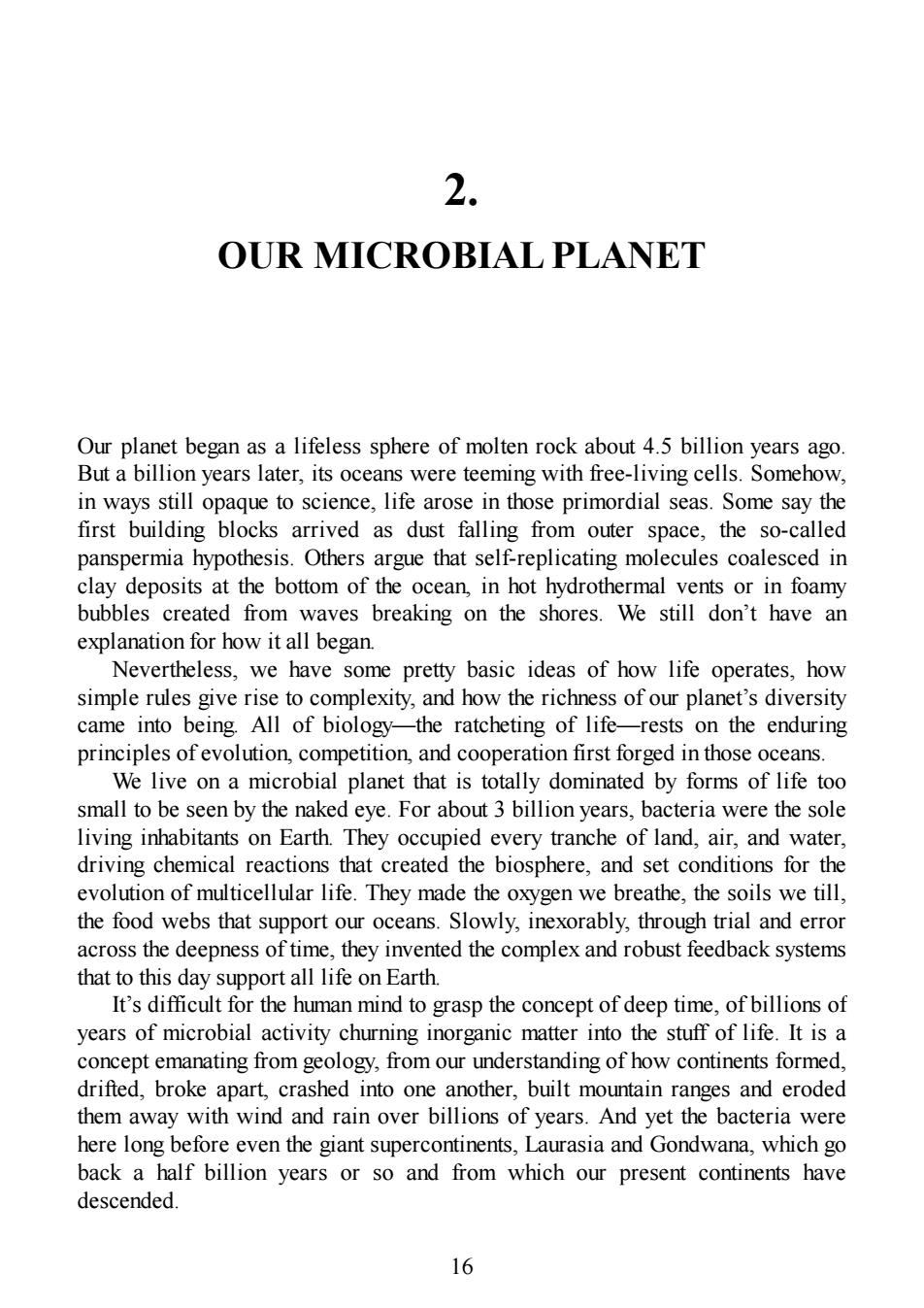正在加载图片...

2. OUR MICROBIAL PLANET Our planet began as a lifeless sphere of molten rock about 4.5 billion years ago But a billion years later,its oceans were teeming with free-living cells.Somehow, in ways still opaque to science,life arose in those primordial seas.Some say the first building blocks arrived as dust falling from outer space,the so-called panspermia hypothesis.Others argue that self-replicating molecules coalesced in clay deposits at the bottom of the ocean,in hot hydrothermal vents or in foamy bubbles created from waves breaking on the shores.We still don't have an explanation for how it all began. Nevertheless,we have some pretty basic ideas of how life operates,how simple rules give rise to complexity,and how the richness of our planet's diversity came into being All of biology-the ratcheting of life-rests on the enduring principles of evolution,competition,and cooperation first forged in those oceans. We live on a microbial planet that is totally dominated by forms of life too small to be seen by the naked eye.For about 3 billion years,bacteria were the sole living inhabitants on Earth.They occupied every tranche of land,air,and water, driving chemical reactions that created the biosphere,and set conditions for the evolution of multicellular life.They made the oxygen we breathe,the soils we till the food webs that support our oceans.Slowly,inexorably,through trial and error across the deepness of time,they invented the complex and robust feedback systems that to this day support all life on Earth. It's difficult for the human mind to grasp the concept of deep time,of billions of years of microbial activity churning inorganic matter into the stuff of life.It is a concept emanating from geology,from our understanding of how continents formed, drifted,broke apart,crashed into one another,built mountain ranges and eroded them away with wind and rain over billions of years.And yet the bacteria were here long before even the giant supercontinents,Laurasia and Gondwana,which go back a half billion years or so and from which our present continents have descended 62. OUR MICROBIAL PLANET Our planet began as a lifeless sphere of molten rock about 4.5 billion years ago. But a billion years later, its oceans were teeming with free-living cells. Somehow, in ways still opaque to science, life arose in those primordial seas. Some say the first building blocks arrived as dust falling from outer space, the so-called panspermia hypothesis. Others argue that self-replicating molecules coalesced in clay deposits at the bottom of the ocean, in hot hydrothermal vents or in foamy bubbles created from waves breaking on the shores. We still don’t have an explanation for how it all began. Nevertheless, we have some pretty basic ideas of how life operates, how simple rules give rise to complexity, and how the richness of our planet’s diversity came into being. All of biology—the ratcheting of life—rests on the enduring principles of evolution, competition, and cooperation first forged in those oceans. We live on a microbial planet that is totally dominated by forms of life too small to be seen by the naked eye. For about 3 billion years, bacteria were the sole living inhabitants on Earth. They occupied every tranche of land, air, and water, driving chemical reactions that created the biosphere, and set conditions for the evolution of multicellular life. They made the oxygen we breathe, the soils we till, the food webs that support our oceans. Slowly, inexorably, through trial and error across the deepness of time, they invented the complex and robust feedback systems that to this day support all life on Earth. It’s difficult for the human mind to grasp the concept of deep time, of billions of years of microbial activity churning inorganic matter into the stuff of life. It is a concept emanating from geology, from our understanding of how continents formed, drifted, broke apart, crashed into one another, built mountain ranges and eroded them away with wind and rain over billions of years. And yet the bacteria were here long before even the giant supercontinents, Laurasia and Gondwana, which go back a half billion years or so and from which our present continents have descended. 16